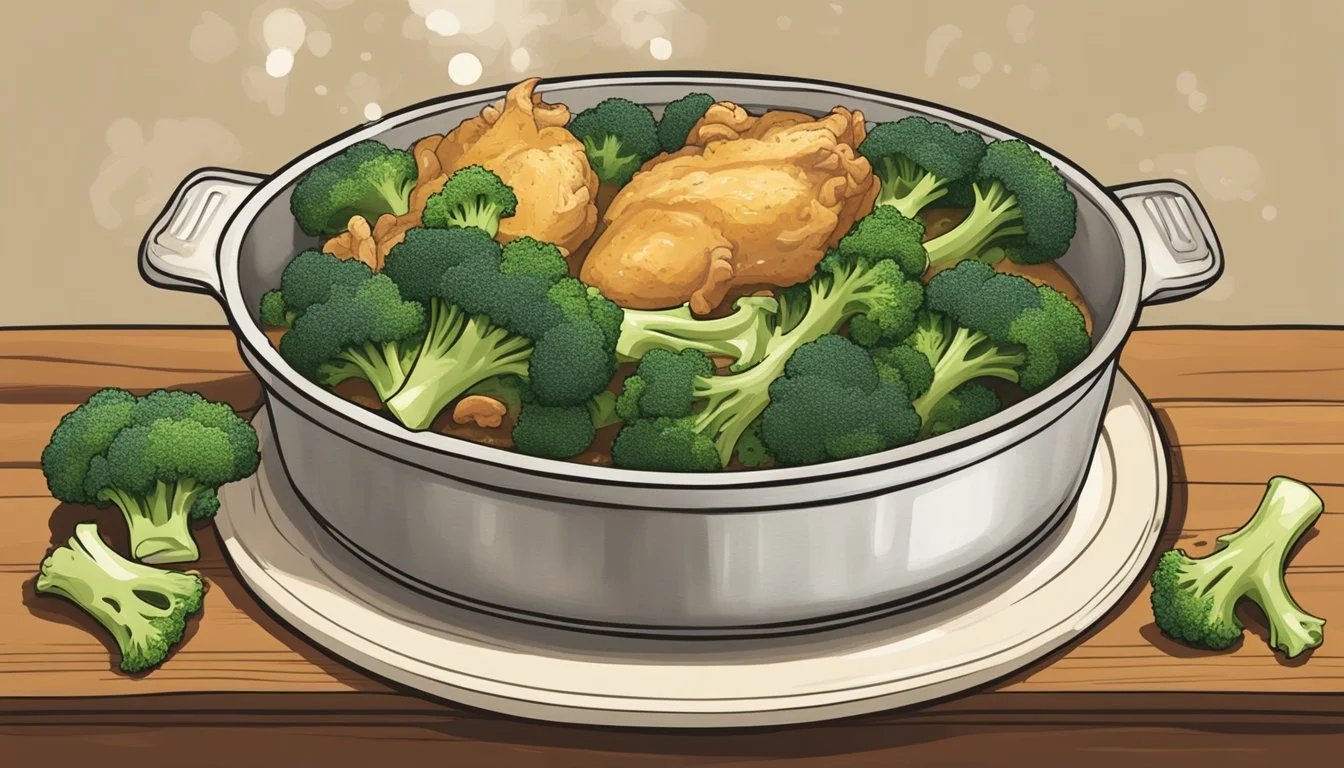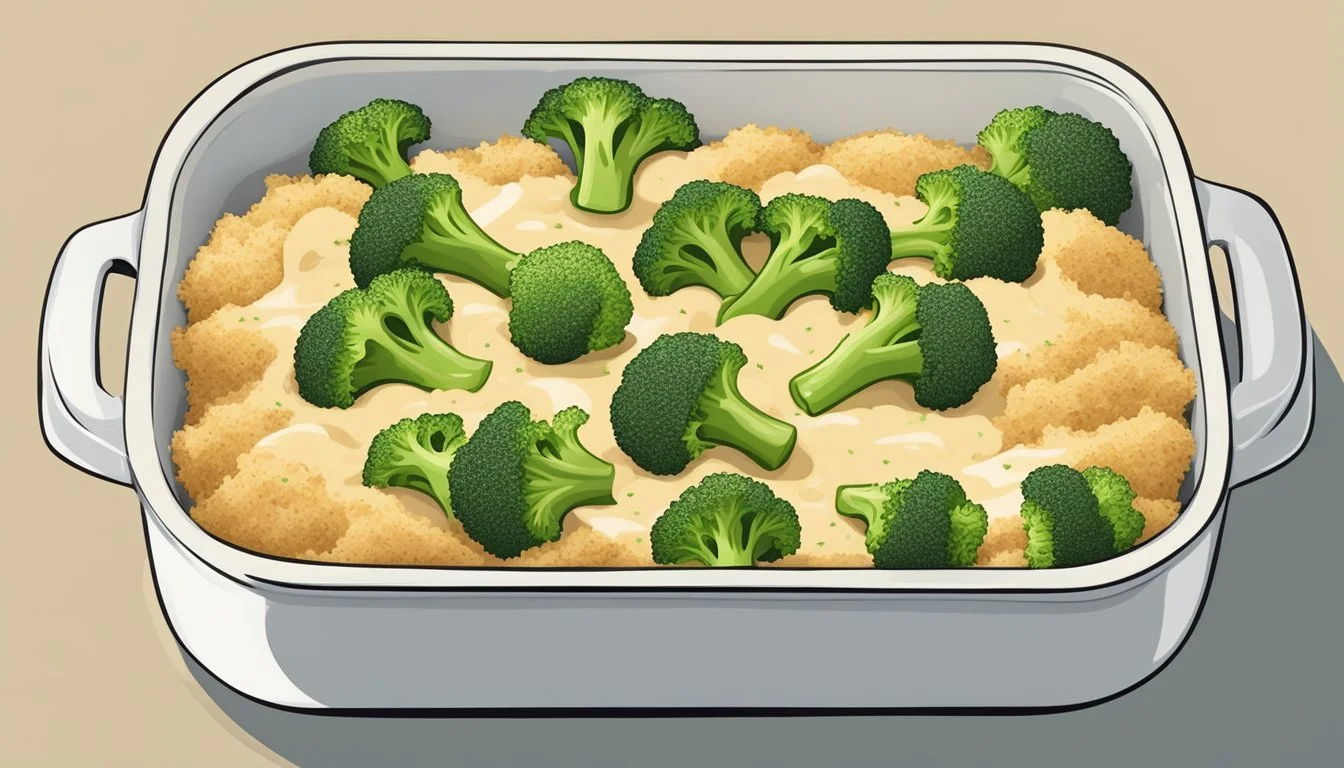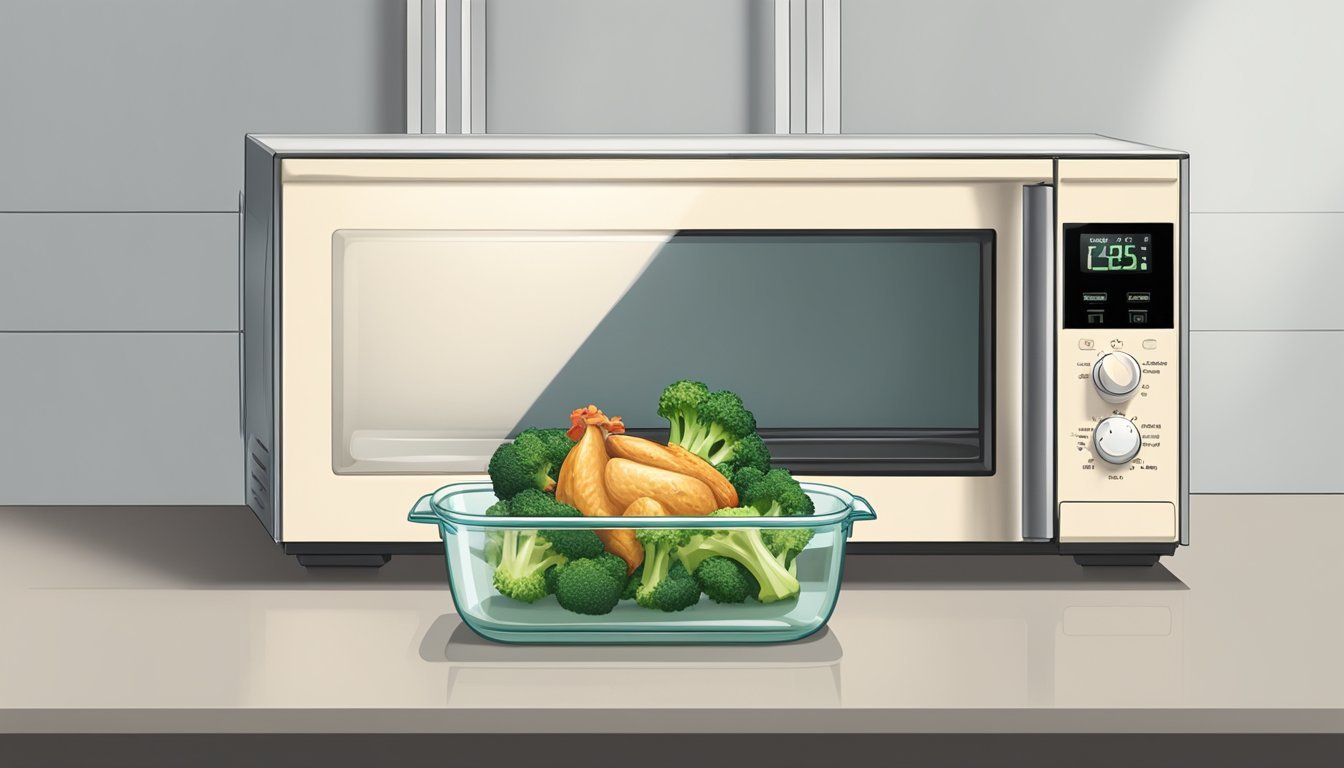How Long Does Chicken and Broccoli Casserole Last?
Storage Tips and Shelf Life
When cooking up a delicious chicken and broccoli casserole for your family, it's important to know how long it will last in your refrigerator. Chicken and broccoli casserole can safely be stored in the refrigerator for 3 to 4 days if kept in an airtight container. This timeframe ensures the dish remains fresh and safe to eat while maintaining its texture and flavor.
Many casserole recipes, such as those that include rice, cheese, and creamy sauces, fit well within this storage window. Proper storage is key; be sure to allow the casserole to cool completely before transferring it to the refrigerator. Labeling the container with the date can help keep track of when it was made, so there's no question about its freshness later on.
Understanding these storage guidelines allows you to enjoy your homemade casserole without worrying about food safety. Reheating the dish until it is steaming hot all the way through before serving ensures that it’s both tasty and safe to consume.
Understanding Chicken and Broccoli Casserole
Chicken and broccoli casserole is a popular comfort food known for its rich flavors and nutritional benefits.
Ingredients
Chicken: Often used as the primary protein source, provides essential amino acids and supports muscle growth.
Broccoli: Adds fiber and vitamins, balancing the dish with its crisp texture.
Cheese: Commonly included to enhance flavor and add a creamy texture.
Preparation
Most recipes require pre-cooking the chicken and broccoli. Chicken is usually cut into bite-sized pieces and cooked to be tender. Broccoli can be steamed or blanched to maintain its crispness.
Baking
Ingredients are mixed with a binding agent, such as cheddar cheese soup, cream of chicken soup, or a combination of sour cream and chicken stock. This mixture is then placed in a baking dish and often topped with cheese or stuffing for added texture.
Cooking Times
Oven temperatures generally range from 350°F to 400°F. Baking time is usually between 20 to 30 minutes, until the casserole is bubbly and the topping is golden brown.
Nutritional Value
This casserole offers a good balance of protein from chicken and fiber from broccoli. Cheese contributes calcium and adds calorie density, making the dish both nutritious and fulfilling.
Popular Variations
Some recipes include rice or pasta for additional bulk.
Different soups (like cream of mushroom) can be used to alter the flavor profile.
Serving Suggestions
Chicken and broccoli casserole pairs well with a fresh salad or garlic bread, making it a versatile main course suitable for family dinners or gatherings.
Essential Ingredients
Creating a delicious Chicken and Broccoli Casserole involves selecting the right ingredients to enhance flavor, texture, and satisfaction. This guide outlines key components, cheese varieties, and vegetable selection essential for an incredible casserole.
Key Components
The base of the casserole centers on chicken and broccoli. Chicken should be cooked and diced, providing protein and a hearty texture. Fresh broccoli, cut into florets, adds a crisp, nutritious element.
Other key ingredients include cream-based soups such as cream of chicken or cheddar cheese soup. These help to create a creamy, flavorful sauce. A binder, often sour cream or mayonnaise, aids in holding the casserole together.
Rice or stuffing can also be used to add bulk and appeal. Ingredients like onions, garlic, and seasonings such as oregano and thyme can be sautéed to add depth of flavor.
Cheese Varieties
Cheese plays a pivotal role in any casserole. Cheddar cheese, whether sharp or mild, is a common choice due to its rich flavor and melting properties.
Parmesan cheese can be used to add a salty, nutty taste, either mixed into the casserole or sprinkled on top for a crispy finish.
For those looking to add a creamier texture, cream cheese blends can be incorporated.
Mixing different cheeses like mozzarella or Monterey Jack provides a more complex flavor profile. Using cheese not only enhances taste but also gives the casserole a more appealing, melted texture.
Vegetable Selection
Fresh vegetables are a vital part of a chicken and broccoli casserole. While broccoli is a staple, options like cauliflower and mushrooms can be included to diversify the vegetable content.
Cauliflower offers a similar texture to broccoli but with a milder flavor. Mushrooms, preferably sautéed, add an earthy richness that complements the chicken.
When including frozen vegetables like broccoli, ensure they are well-drained to prevent excess moisture.
Combining different veggies ensures a well-rounded, nutritious dish that’s both pleasing to the palate and visually appealing.
Using a variety of fresh vegetables not only boosts the nutritional value but also adds different textures and flavors to the casserole.
Preparation Techniques
Proper preparation is key to ensuring that a chicken and broccoli casserole comes out delicious and well-cooked. The steps generally involve mixing ingredients and layering them in a baking dish, followed by baking in an oven.
Mixing and Layering
Start by preheating the oven to the desired temperature, typically between 350°F and 425°F based on the specific recipe.
In a large mixing bowl, whisk together any sauces or soups, such as condensed soups, mayonnaise, sour cream, and seasonings like garlic powder and onion powder. This mixture will act as the base for the casserole's flavor.
Next, fold in the main ingredients: diced cooked chicken, thawed frozen broccoli, and possibly other elements like rice or pasta. Ensure that all components are coated evenly by stirring thoroughly.
Transfer this mixture to a greased or sprayed baking dish. Spread it out evenly with a spatula to create a uniform layer. If specified in the recipe, certain ingredients like cheese or additional seasonings should be layered on top at this stage for extra flavor.
Baking Instructions
Place the prepared baking dish into the preheated oven. Bake for a time frame of 30-40 minutes, depending on your oven and the recipe's directions.
It's important to bake until the casserole is bubbly and the top is golden brown. The internal temperature of the dish should reach at least 165°F to ensure all ingredients, especially the chicken, are fully cooked.
About halfway through the baking, it's wise to check on the dish and rotate it if necessary. This helps in achieving an even bake.
Once done, remove the casserole from the oven and let it sit for a few minutes before serving. This resting period allows the flavors to meld and makes it easier to cut and serve.
Proper Storage Methods
Storing chicken and broccoli casserole properly ensures its freshness and safety for consumption. Key methods involve refrigeration and freezing.
Refrigeration Guidelines
Chicken and broccoli casserole can be stored in the refrigerator for up to 3-4 days. Using airtight containers is critical to prevent moisture loss and contamination. Glass or plastic containers with tight-fitting lids work well.
To help retain moisture, cover the casserole with aluminum foil before closing the lid. Additionally, avoid leaving the casserole at room temperature for more than 2 hours. This helps prevent bacterial growth that can cause spoilage.
Labeling the containers with the date helps in keeping track of the storage duration. Reheat leftovers in the oven or a skillet for best results, avoiding the microwave to maintain texture.
Freezing Tips
For longer storage, freezing is a viable option. Cut the casserole into individual portions to make reheating easier. Wrap each portion tightly with aluminum foil and place them in airtight containers or silicone freezer bags.
Before freezing, ensure the casserole has cooled completely to avoid ice crystal formation. Arrange the wrapped portions on a baking sheet to freeze them individually before transferring to containers or bags. This prevents sticking together.
When ready to eat, thaw the portions overnight in the refrigerator. Reheat in an oven at 350°F (175°C) until heated through, which typically takes 20-30 minutes. This method preserves the casserole’s flavor and texture.
Shelf Life and Freshness
Chicken and broccoli casserole is a versatile dish that can be efficiently stored in both the refrigerator and the freezer. Knowing how long it can last in different conditions ensures that it stays safe to eat.
In the refrigerator, a cooked chicken and broccoli casserole typically lasts for 3-4 days. It should be kept at or below 40°F (4°C) to prevent bacterial growth. Ensure it's stored in an airtight container to maintain its freshness and minimize odors mingling with other foods.
For longer storage, the casserole can be frozen. Properly wrapped in aluminum foil or placed in a freezer-safe container, it can last for 2-3 months. When ready to consume, thaw it in the refrigerator overnight before reheating.
Leftovers from the casserole can also follow these guidelines. Always label the dates on containers to keep track of how long the casserole has been stored. Remember to reheat leftovers to an internal temperature of 165°F (74°C) to ensure safety.
Adhering to these storage times helps maintain the shelf life and freshness of the chicken and broccoli casserole, ensuring it remains safe and tasty.
Reheating Instructions
Reheating chicken and broccoli casserole can be done using either a microwave or an oven. Choosing the right method depends on how much time you have and your preference for texture.
Microwave Method
Preparation: Place the desired portion of chicken and broccoli casserole in a microwave-safe dish. Cover it with a microwave-safe lid or plastic wrap, leaving a small vent for steam to escape.
Heating: Set the microwave on medium power to ensure even heating. Heat the casserole for about 2-3 minutes.
Stir and Continue: After the initial heating, stir the casserole to ensure the heat is distributed evenly. Place it back in the microwave for an additional 1-2 minutes, or until the casserole is heated through.
Check Temperature: Use a food thermometer to ensure the internal temperature reaches 165°F (74°C). This ensures that the casserole is hot and safe to eat.
Serving: Let it sit for a minute before serving, as microwave-heated food can have hot spots.
Oven Technique
Preheat: Preheat your oven to 350°F (175°C).
Prepare the Dish: Place the casserole in an oven-safe dish if it isn't already in one. Cover the dish loosely with aluminum foil to retain moisture without trapping too much steam.
Warm Slowly: Put the covered dish in the oven. Heat for about 20 minutes if the casserole is in a thick layer. For smaller or thinner portions, 15 minutes might be enough.
Check Heat: Remove the foil for the last 5 minutes if you want a bubbly, slightly crispy top. Ensure the internal temperature reaches 165°F (74°C).
Rest Before Serving: Let the casserole rest for a few minutes before serving to allow the heat to distribute evenly.
Safety Considerations
When storing a chicken and broccoli casserole, safety is crucial. Leftovers should be promptly refrigerated within two hours of cooking to prevent bacterial growth.
Maintain the fridge temperature at or below 40°F (4°C). This helps keep the casserole at a safe temperature, reducing the risk of foodborne illness.
Chicken in the casserole should last in the fridge for three to four days. Always reheat leftovers to an internal temperature of 165°F (74°C) before eating.
For best results, use a food thermometer to check safe temperature. Improperly stored leftovers can cause food poisoning, so follow these guidelines strictly for safe consumption.
Nutritional Information
Chicken and broccoli casserole provides a range of essential nutrients, including protein, fiber, and various vitamins and minerals. This section provides a detailed look at the key nutritional components.
Macros and Calories
A standard serving of chicken and broccoli casserole typically contains around 391 calories. The main macronutrients in this dish are:
Protein: Approximately 20-25 grams, mostly from chicken.
Fat: Around 25 grams, with about 10 grams being saturated fat. The remaining fats are a mix of polyunsaturated and monounsaturated fats.
Carbohydrates: Varies depending on additional ingredients like rice or pasta, generally around 20-30 grams.
The calorie count and macronutrient composition may vary based on specific ingredients.
Dietary Benefits
Chicken and broccoli casserole offers considerable dietary benefits. Protein is crucial for muscle repair and growth. Broccoli adds fiber, aiding in digestion and improving gut health. Additionally, the dish often includes essential vitamins like Vitamin C and Vitamin K from broccoli.
The fat content provides essential fatty acids and energy. However, due to the presence of saturated fats, it's advisable to consume in moderation. With its blend of proteins, fibers, and essential nutrients, this casserole can be a balanced meal option when paired with other healthy food choices.
Recipe Variations and Substitutions
Adjusting the ingredients in a chicken and broccoli casserole can yield delicious and varied results. Different types of cheese, soups, and vegetables can be incorporated, allowing for flexibility based on dietary preferences and available ingredients.
Alternative Ingredients
Chicken: Instead of using chicken breasts, rotisserie chicken can be an excellent substitute, providing a richer flavor and saving preparation time. For vegetarians, tofu or tempeh can replace chicken.
Broccoli: Both fresh and frozen broccoli work well in this casserole. Fresh broccoli may require a brief blanching to ensure it cooks fully, while frozen broccoli should be thawed and drained to avoid excess moisture.
Cheese: While cheddar cheese is a popular choice, alternatives like parmesan cheese or mozzarella can be used for different flavor profiles. Combining multiple cheeses can also enhance the dish's complexity.
Soup Base: Cream of chicken soup is commonly used, but cream of mushroom or cream of broccoli soups can serve as substitutes, catering to different tastes or dietary needs.
Creative Add-Ins
Vegetables: Adding more vegetables can increase the nutritional value and depth of the casserole. Mushrooms, carrots, and peas are tasty options that blend well with chicken and broccoli.
Grains: Introducing grains like quinoa or wild rice can make the casserole heartier. These grains provide additional texture and nutrients.
Spices and Herbs: To elevate the flavor, consider incorporating spices such as garlic powder, onion powder, or paprika. Fresh herbs like thyme or parsley can add a vibrant taste and appealing aroma.
Toppings: Breadcrumbs, stuffing mix, or crushed crackers can be sprinkled on top for a crispy texture. Drizzling with a bit of melted butter before baking helps achieve a golden-brown crust.
Making Chicken and Broccoli Casserole Ahead
Making Chicken and Broccoli Casserole ahead of time can simplify meal planning.
For up to 2 days in advance, assemble the casserole without baking. Store it in the refrigerator, covered tightly with plastic wrap or foil. Baking, while refrigerating, may increase cooking time by an additional 10-15 minutes.
When freezing, assemble the casserole and wrap it in several layers of plastic wrap and foil. Freeze for up to 2 months. When ready to bake, thaw in the refrigerator overnight.
Table for Storage Times:
Refrigerator (Unbaked) Freezer (Unbaked) Up to 2 days Up to 2 months
Instructions may include adjusting cooking times:
Refrigerated: Preheat oven to specified temperature in your recipe. Add 10-15 minutes to total baking time.
Frozen: Thaw overnight in the refrigerator. Follow original baking instructions, monitoring to ensure proper cooking.
Serving Suggestions
When serving chicken and broccoli casserole, consider both the accompaniments that complement it well and the presentation tips to make it visually appealing.
Accompaniments
Pairing chicken and broccoli casserole with the right side dishes can elevate the meal. Garlic bread or buttered noodles make excellent carb-based sides. For a lighter touch, a Caesar salad or quinoa salad adds freshness and balance.
Another option is mashed potatoes, which provide a creamy texture that complements the savory casserole. Additionally, roasted vegetables like carrots or Brussels sprouts can add a touch of sweetness and enhance the overall flavor profile.
Presentation Tips
A well-presented dish can make a big difference. Use a clean and decorative baking dish. This not only makes it easy to serve but also adds to the dish's appeal.
For an enticing look, sprinkle Parmesan cheese or fresh herbs like thyme or oregano on top before serving. Arrange garnish neatly and ensure even portions.
Taking time to present the dish well will make it even more enjoyable to eat.












